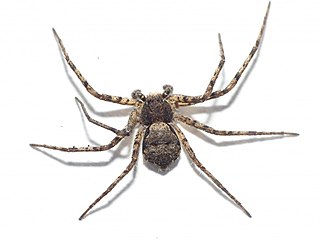
Spitting spiders (Scytodidae) is a family of araneomorph spiders first described by John Blackwall in 1864. It contains over 250 species in five genera, of which Scytodes is the best-known.

The diving bell spider or water spider is the only species of spider known to live almost entirely under water. It is the only member of the genus Argyroneta. When out of the water, the spider ranges in colour from mid to dark brown, although the hairs on the abdomen give it a dark grey, velvet-like appearance. It is native to freshwater habitats in Europe and Asia.

Tord Tamerlan Teodor Thorell was a Swedish arachnologist.

Deinopis, also known as net-casting spiders, gladiator spiders and ogre-faced spiders, is a genus of net-casting spiders that was first described by W. S. MacLeay in 1839. Its distribution is widely tropical and subtropical. They catch their prey using a specially spun "net". The name is derived from the Greek δεινός (deinos), meaning "fearful", and opis, meaning "appearance", referring to their ogre-like faces. The spelling "Dinopis" is also found, but is regarded as an "unjustified emendation".

Hakea bucculenta, commonly known as red pokers, is a large shrub in the family Proteaceae endemic to Western Australia. A spectacular ornamental shrub with red or orange flowers that appear in rod-like blooms in leaf axils for an extended period from May to November.

ChemSpider is a database of chemicals. ChemSpider is owned by the Royal Society of Chemistry.

The book Svenska Spindlar or Aranei Svecici was one of the major works of the Swedish arachnologist and entomologist Carl Alexander Clerck and appeared in Stockholm in the year 1757. It was the first comprehensive book on the spiders of Sweden and one of the first regional monographs of a group of animals worldwide. The full title of the work was Svenska Spindlar uti sina hufvud-slägter indelte samt under några och sextio särskildte arter beskrefne och med illuminerade figurer uplyste – Aranei Svecici, descriptionibus et figuris æneis illustrati, ad genera subalterna redacti, speciebus ultra LX determinati, and included 162 pages of text and 6 colour plates. It was published in Swedish, with a Latin translation printed in a slightly smaller font below the Swedish text.

Araneus angulatus is a species of orb-weaving spiders found in the Palearctic realm. It resembles the European garden spider, Araneus diadematus, but has distinctive tubercles on its abdomen. The species was first described in Aranei Svecici in 1757, where it was the first species described, making Araneus angulatus the first scientific name of an animal that is still in use.

Composita is an extinct brachiopod genus that lived from the Late Devonian to the Late Permian. Composita had a cosmopolitan global distribution, having lived on every continent except Antarctica. Composita had a smooth shell with a more or less distinct fold and sulcus and a round opening for the pedicle on the pedicle valve. Composita is included in the family Athyrididae and placed in the subfamily Spirigerellinae.

Eratigena is a genus of spider in the family Agelenidae. Most of its species were moved from the genus Tegenaria in 2013. Two species that frequently build webs in and around human dwellings are now placed in this genus. Eratigena agrestis is the hobo spider, native to Europe and Central Asia, introduced to North America. Eratigena atrica is the giant house spider, native to Europe and also introduced into North America.
Utivarachna is a genus of Asian araneomorph spiders in the family Trachelidae first described by Kyukichi Kishida in 1940. It was largely ignored until Christa L. Deeleman-Reinhold revised the sac and ground spiders in 2001, transferring some species from Trachelas and adding several new ones. The genus was further expanded in 2014 and 2015.
Trechalea is a genus of spider in the family Trechaleidae, found in the United States to Peru and Brazil.
Oedignatha is a genus of Asian spiders first described by Tamerlan Thorell in 1881 as a genus of corrinid sac spiders, and moved to Liocranidae in 2014.
Niklas Westring was a Swedish entomologist and arachnologist.
Hugo Albert Tullgren was a Swedish entomologist and arachnologist.

Floronia is a genus of spiders in the family Linyphiidae first described by Eugène Simon in 1887.

Kochiura is a genus of comb-footed spiders that was first described by Allan Frost Archer in 1950.
Pardosa pullata is a species of spiders from genus Pardosa in the family Lycosidae. It was described by Clerck, in 1757.

Philodromus margaritatus is a species of philodromid crab spiders. It is found in New Jersey, Europe, Turkey, Caucasus, Russia to Kazakhstan, Korea and Japan.













